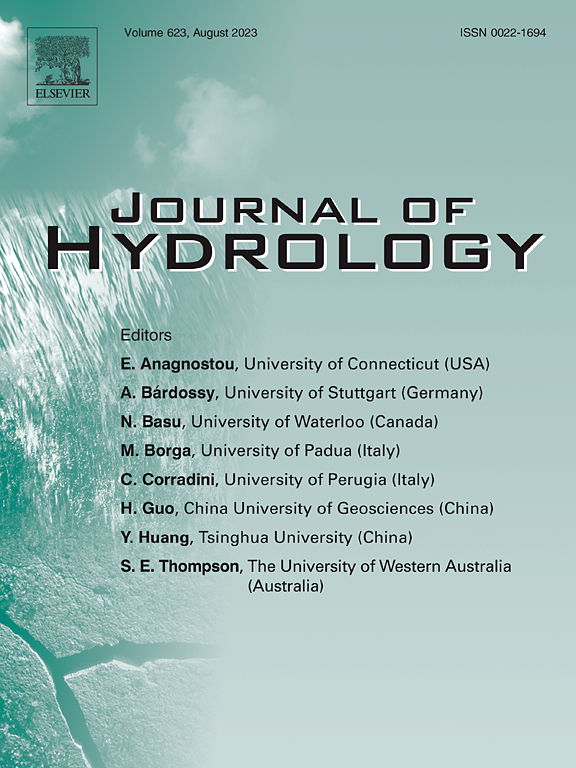Derivation and analysis of spatial variability in master recession curves with mixed effects model
IF 6.3
1区 地球科学
Q1 ENGINEERING, CIVIL
引用次数: 0
Abstract
Master recession curves, often modeled by the equation dQ/dt = -AQB, are widely used to analyze hydrological responses, develop hydrological models, and assess basin storage. However, traditional methods for deriving these curves often overlook the correlation between recession data of individual events. In this study, we applied three conventional methods and the mixed effects model that accounts for data correlation to derive master recession curves across 425 U.S. basins. The conventional methods include the lower envelope, point cloud regression, and two stage approaches. We evaluated the effectiveness of each method by comparing characteristic recession timescales and conducted stepwise regressions to investigate sources of cross-basin variability in the master recession curves. Key findings include: (1) master recession curve estimation is significantly sensitive to the fitting method (p < 0.05), with the sensitivity largely stemming from the high responsiveness of parameter A to the fitting approach; (2) the mixed effects model proves a valuable complement to traditional methods, with errors in recession timescale estimates from traditional methods being 1.78 to 30 times larger than those from the mixed effects model; (3) parameters A and B both vary considerably across basins even when derived with the same method, with parameter A showing more pronounced variability; and (4) parameter A’s spatial variability closely associates with vegetation cover, while parameter B’s variability shows a weaker and less consistent connection to geographic characteristics. The mixed effects model introduced here offers an alternative for deriving master recession curves, enhancing understanding of their spatial variability and providing insights for modeling master recession curves in data-scarce regions.
混合效应模型下主衰退曲线空间变异性的推导与分析
主衰退曲线通常由方程dQ/dt = -AQB建模,被广泛用于分析水文响应、开发水文模型和评估流域储量。然而,推导这些曲线的传统方法往往忽略了单个事件衰退数据之间的相关性。在这项研究中,我们采用了三种常规方法和混合效应模型,该模型考虑了数据相关性,得出了美国425个盆地的主衰退曲线。传统的方法包括下包络线法、点云回归法和两阶段法。我们通过比较特征衰退时间尺度来评估每种方法的有效性,并通过逐步回归来研究主衰退曲线跨流域变异的来源。主要发现包括:(1)主衰退曲线估计对拟合方法显著敏感(p <;0.05),其敏感性主要源于参数A对拟合方法的高响应性;(2)混合效应模型是对传统方法的有益补充,传统方法对衰退时间尺度的估计误差是混合效应模型的1.78 ~ 30倍;(3)在相同方法下,参数A和B在不同流域间的差异较大,其中参数A的变异性更明显;(4)参数A的空间变异性与植被覆盖密切相关,而参数B的空间变异性与地理特征的联系较弱,一致性较差。本文引入的混合效应模型为主衰退曲线的推导提供了一种替代方法,增强了对其空间变异性的理解,并为数据稀缺地区主衰退曲线的建模提供了见解。
本文章由计算机程序翻译,如有差异,请以英文原文为准。
求助全文
约1分钟内获得全文
求助全文
来源期刊

Journal of Hydrology
地学-地球科学综合
CiteScore
11.00
自引率
12.50%
发文量
1309
审稿时长
7.5 months
期刊介绍:
The Journal of Hydrology publishes original research papers and comprehensive reviews in all the subfields of the hydrological sciences including water based management and policy issues that impact on economics and society. These comprise, but are not limited to the physical, chemical, biogeochemical, stochastic and systems aspects of surface and groundwater hydrology, hydrometeorology and hydrogeology. Relevant topics incorporating the insights and methodologies of disciplines such as climatology, water resource systems, hydraulics, agrohydrology, geomorphology, soil science, instrumentation and remote sensing, civil and environmental engineering are included. Social science perspectives on hydrological problems such as resource and ecological economics, environmental sociology, psychology and behavioural science, management and policy analysis are also invited. Multi-and interdisciplinary analyses of hydrological problems are within scope. The science published in the Journal of Hydrology is relevant to catchment scales rather than exclusively to a local scale or site.
 求助内容:
求助内容: 应助结果提醒方式:
应助结果提醒方式:


